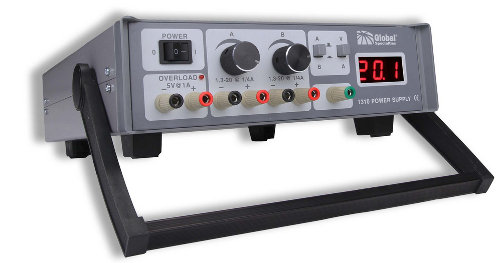
Obviously you will need a power supply to power your creation, probably 5V. There are plenty of possibilities, ranging from batteries (not discussed here) to wall-warts (you probably use a small version of a wall-wart to charge your phone) to nice, adjustable workbench power supplies with voltage and current meters. If you use a wall-wart, make sure it's regulated at 5V, or put a regulator on your computer board. The LM7805 (.pdf) is a popular one that's simple to use, and tough. Be sure to put 0.1µF capacitors at its input and output, close to the pins.
I use the Global Specialties 1310 which is a triple power supply (and is actually good for quite a bit more current on the two variable-voltage supplies that the specifications say) and looks like this:

The 1300 is an older version of the same thing, having an analog meter instead of digital. These two have an outstanding reliability record. They have three separate, isolated outputs: a 5V one, and two that are labeled 1.3V-20V and 1/4 amp but are good for at least twice that much current and a little wider voltage range too. These are good for separate higher-voltage plus and minus supplies for your projects, like you might need for op amps, a speaker amplifier, the negative LCD backplane voltage needed by some of the supertwist LCDs, analog switch ICs, etc., and with the higher voltages there, you can use the 16-pin MC145406 triple RS-232 line driver and receiver (same thing as the SN75C1406) instead of the well known MAX232 which only has fewer line drivers and receivers yet takes more board space because of the external capacitors it requires for its charge pump, and the extra pins to connect them. The closest thing Global has now (Jan 2022) is the 1403 which has a lot more current capacity and unfortunately is also a lot more expensive ($390US, Apr 2024).
But perhaps a better one than the 1403, for less money, is the Volteq HY3003D which has two 0-30V 0-3A supplies plus a fixed 5V 3A one, for $180US, down from $300 (in Apr 2024):
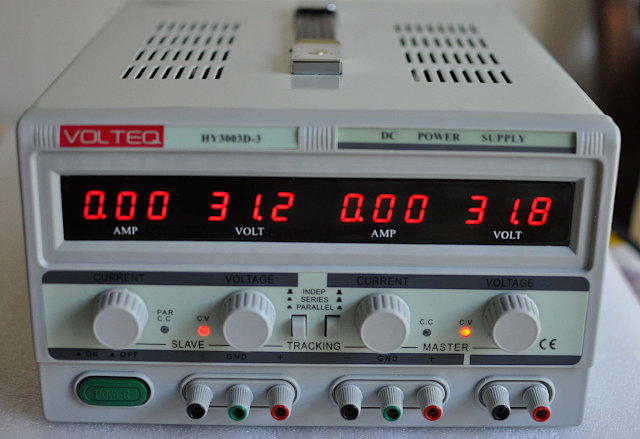
A cheaper way to get +5V and ±12V, although non-adjustable and lacking a nice case, is something like the TDK Lambda 51212 for under $45US (Apr 2024):
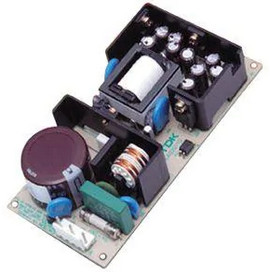
You can find similar things for half the price or less from places like AliExpress, but I can't vouch for how long any given model will be available. Lambda (above) has been making power supplies like this for decades. Power One is another. I'm sure a search would turn up a suitable triple-output wall-wart or table-top power supply as well.
Whatever power supply you use, make sure it does not overshoot the desired voltage for an instant when you turn it on, as that could damage the ICs in the computer you just made. (I mention this because I've seen some integrated switching regulators that do overshoot upon turn-on.) Also, if it is adjustable, make sure you verify the correct voltage before powering the computer up, unless the computer has its own 5V regulator.
You will also need a decent DMM (digital multimeter). Actually, it doesn't particularly need to be digital,
but most of them today are, and I've never seen an analog multimeter (often called a VOM, for "voltmeter-ohmmeter-milliammeter") with a
capacitance tester, frequency counter, transistor tester, diode test, or beep-on-continuity which come pretty standard on mid-range DMMs.
The analog ones generally are not as sensitive either, meaning that they will more-heavily load whatever circuit you're trying to make a
measurement on. You don't have to spend $100, let alone $400, but $25 probably is not enough. There are plenty of good ones
starting at $40-$60. Go to Jameco's (or other distributor's) website and put "DMM"
in the search bar. I'm still using a Metex M-3650 I bought from Jameco in the 1980's, and operationally it seemed to still be in
brand-new condition, until Apr 2024 when the capacitance test portion quit working, nearly 40 years after I bought it.
An oscilloscope is not always an absolute necessity, but it's awfully good to have. If you can afford one,
then it's a necessity! :D Basic new ones seem to start at under $300. You'll need, as an absolute minimum, dual-trace,
triggered, and 20MHz. (Don't expect a 20MHz 'scope to give a good representation of a 20MHz square wave though. For that, you'd
need at least a couple hundred MHz.) Basic stand-alone 'scopes now seem to meet all of those, in fact start at 40 or 60MHz which is
better than 20MHz. Pocket digital 'scopes made for audio probably won't do you much good for your home-made-computer hobby. [Update,
1/1/24: It looks like most of the major manufacturers have dropped their analog 'scopes. It looks like there are still some Chinese and
Indian manufacturers, and there are plenty of used ones on eBay. The prices of all these are a fraction of the price of a new digital one.]
One thing I will insist on is that you get a good pair of probes, and use them in the x10 switch position. In the x10 position, the oscilloscope's 0.1V-per-division setting becomes 1V per division, and so on; but probes are never any good for the higher speeds in the x1 position! If you buy a new 'scope, it will come with probes. Take care of them, because they're not cheap to replace. [Update, Jan 2022: Now I see ones on eBay down to $10. I half expect that they're garbage.] There's a lot more to good probes than meets the eye, and a decent pair for a low-end oscilloscope will cost you at least $30 or $40. (They can be many times that price for the faster 'scopes!) If you get a used 'scope, either be sure you get good probes with it, or budget some money to buy some.
Dave Jones has a rant about oscilloscopes on his EEVblog #86, and frankly, he's right. His basic message in this one is that cheap 'scopes like the DSO Nano are worthless; and after seeing his review of it, I totally agree! His recommendation—actually his pleading, after all the times he's been asked about the cheapie 'scopes—is that if you're on a tight budget, then get yourself a used, basic 20MHz dual-trace triggered oscilloscope which you can sometimes even get for free these days. [Update, 11/11/19: He just posted a review of the $70 FNIRSI-5012H (supposedly) 100MHz bandwidth (supposedly) 500MS/s handheld pocket oscilloscope in his EEVblog #1260. Again, junk in too many ways.] I came across this video review of an oscilloscope attachment and ap for the iPad or iPhone on EEWeb, which I mention because like so many of these that seem to be a nice shortcut way to get something we used to have to pay a lot more for, they say it's very nice to use but its technical specifications are very poor, with only one analog channel, 5MHz bandwidth, 500mV/div with the probe on x10, and a 240-sample screen, which are not adequate for the work we're addressing in this 6502 primer. His EEVblog #1022 from Sep 14, 2017 is on how to find a decent used 'scope for $50 on eBay.
"Shouldn't I go for a digital-storage oscilloscope (DSO)?", you might ask. If you can afford a good one, sure; but do your research before you buy. The company I work for gave me an Agilent (formerly HP) DSO1004A 60MHz 2GSa/s 4-ch digital 'scope which is quite capable but so hard to use that I think I'm done wasting time on it. It is user-hostile! I mentioned that on a forum somewhere, and someone commented that HP/Agilent/Keysight 'scopes have always been that way. The only other digital 'scope I've used was a Philips one at my last place of work, around 1990, and it was very intuitive; but this Agilent can be very difficult to do even the most basic of things (and yes, I've read the entire manual). I wander around the various menus and just can't find what I need, or it keeps putting its settings back to what it thinks they should be. I've seen some sites say that analog is out and don't waste your time on them; but you can sure get a great 400MHz analog scope on eBay for a fraction of what the digital ones cost. I seldom need actual digital storage, as usually I can make whatever I want to observe repeat.
A couple of good 6502.org forum topics on oscilloscopes are:
Cheap oscilloscope and other test equipment and
Recommended oscilloscope features?
A logic probe is cheap but not very often useful. I've never had one, but it wouldn't hurt to get one
if you want to, especially if you don't get an oscilloscope. Here are a couple offered by Jameco. The one in the case is $50.
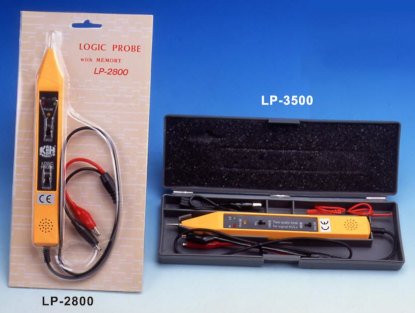
Do not confuse that with a logic analyzer, which has dozens of inputs, an depending on speed and various features, can cost
tens of thousands of dollars:
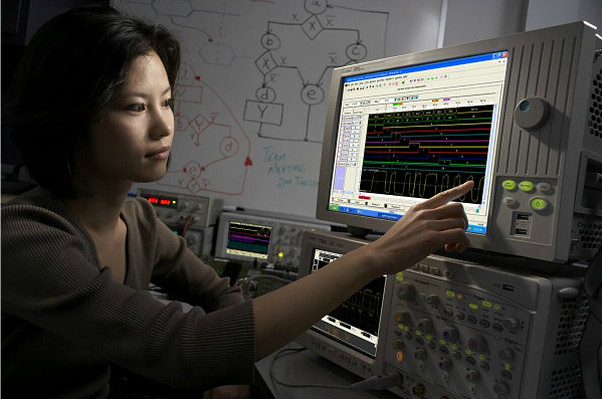
This definitely does not fall in the category of "basic workbench equipment"!
This $70US device programmer that
Jameco sells,
the TL866-3G-T48, seems to be popular.
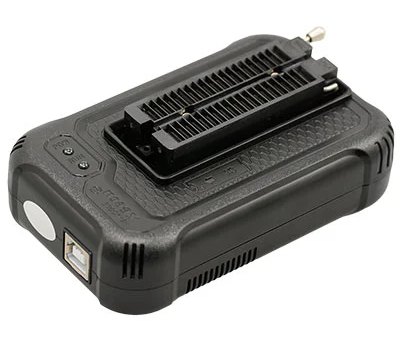
It connects to your PC by a USB cord, and programs EPROMs, EEPROMs, flash memories, and many microcontrollers and other programmable
devices. It comes with a Windows-based software driver. I've bought the earlier version and downloaded the third-party Linux
software Linux-based software. So far, I've only used it for EPROMs. You will normally need a way to program a boot-up
ROM for your computer creation, and this programmer is a lot less expensive than many other options.
I have other pieces of equipment but not anything I would really say you need to get, at least to start.
Working for very small, low-budget companies since 1985 (which I enjoy), I have not had access to much expensive equipment, and being
creative, I have been able to substitute for a lot of equipment using by home-made
workbench computer and/or breadboards that didn't take long to make.
(My job is circuit design, mostly analog but a little digital, so I better be able to whip up that kind of stuff!)
There's a forum topic on low-budget equipment buying and making that especially deals with oscilloscopes here, and one that is all about oscilloscopes here (3 pages so far). (These are the same ones linked above.)
Dave Jones has a video blog on setting up an electronics lab, at
https://www.youtube.com/watch?v=R_PbjbRaO2E. I posted
about it on the sparkfun forum in response to someone's question, and the OP said he didn't think he would need 90% of that stuff. But
like Dave said near the end, a lot of that stuff gets accumulated slowly over the years. He discusses the very basics at the beginning
though, and I definitely agree with most of it. I've seen here where beginners really cause themselves a load of trouble
and frustration by not getting for example a good DMM and power supply like Dave talks about, and an oscilloscope meeting at least the basic
requirements spelled out above. Without an oscilloscope, you're kind of working in the dark. It's far more important than some
of the things (like simulators) that beginners think they need.
Programming tips <--Previous | Next--> schematics & potpourri
last updated Jun 19, 2025